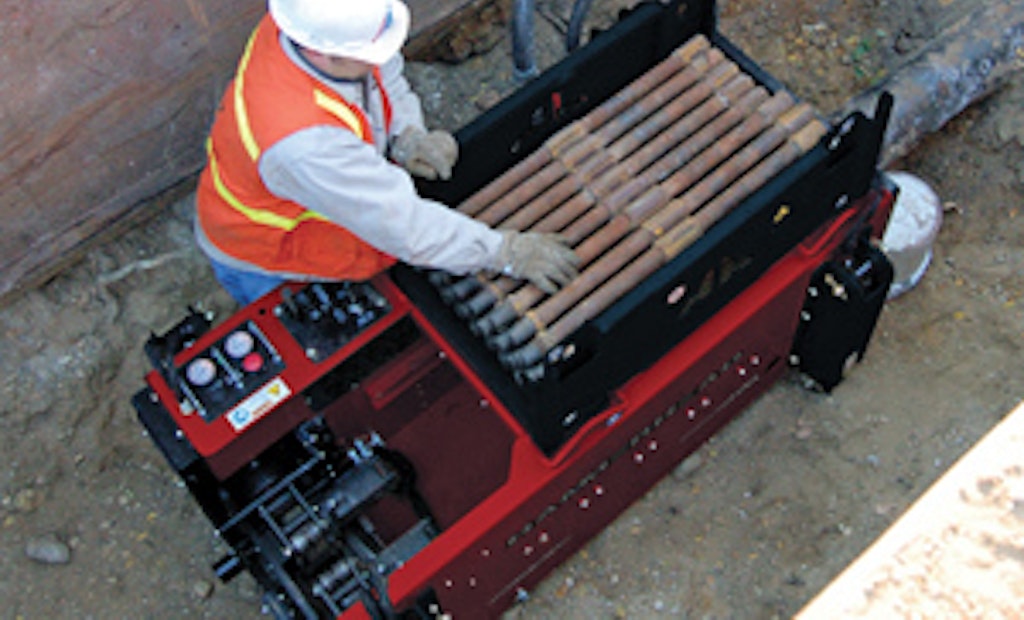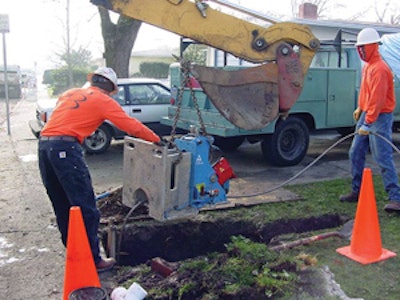
Interested in Relining/Rehab?
Get Relining/Rehab articles, news and videos right in your inbox! Sign up now.
Relining/Rehab + Get AlertsOver the past three decades, pipe bursting technology has become a valuable tool in sewer line construction and maintenance. However, the success of each project owes as much to the design and preparation of the job as its execution.
We asked two industry experts to share a dozen points any contractor should consider before embarking on a pipe bursting job. On deck: Collins Orton, product specialist and California regional sales manager for trenchless equipment manufacturer TT Technologies, of Aurora, Ill., and Alan Goodman, national sales manager, pipe ramming and pipe bursting with HammerHead of Oconomowoc, Wis.
1. Has the existing line been inspected using closed circuit television (CCTV)?
Orton: Anyone performing pipe bursting without a CCTV inspection is very, very foolish. You don’t have X-ray vision. In a lot of cases, you need to get visual confirmation of pipe construction material and any bends in the pipe. You need to look for the laterals and all of the connections, both legal and illegal. If you send a new line through there without camera inspection, you’ll be the first to know about it when the sewer laterals start backing up.
Goodman: Proper CCTV service allows you to see a transition in existing pipe material and if the existing line has a belly or sag. If you’re bursting that line it will try to follow the path of the existing pipe. By increasing the diameter of the existing pipe you can help diminish the belly or sag due to the new pipe diameter. A CCTV inspection after the installation is also the best way of demonstrating that the installation has been completed correctly.
2. Have all other utilities been identified, accurately located and exposed where needed?
Orton: Accurate service location is becoming more and more important, from gas and electrical lines to fiber optic cables. Even if you locate the utility and you don’t know how much room you have between utilities, you have to excavate and expose that crossing to determine what the clearance actually is. We’ve seen cases where the lateral was located an inch or two from a gas line. We’ve even seen a case where the gas company had drilled a 2-inch gas main straight through a sewer lateral.
Goodman: Our rule of thumb is that, for every inch you want to expand, the depth of cover should be 12 times that number to account for proper clearance from other utilities. So if you’re going from a 4-inch line to a 7.2-inch line – a 3.2-inch increase – you would want to be at least 38 to 40 inches from the nearest utility.
3. What is the existing pipe material made of? Are there any transitions of pipe material throughout the run?
Orton: Some pipes are fracturable, some are flexible and can’t break and need to be sliced and spread open. The material in the existing pipe can have an affect on what kind of tools you use, from a simple cone to a bursting head with ribs or blades to provide extra power. Ductile iron is flexible, not fracturable, while cast iron can be burst, so you need to be positive about the pipe material, even to the point of digging and inspecting if you aren’t sure what the pipe is made of. Some plastics are a bit of a grey area with some of them fracturing and some being flexible enough to snap back so that you need a larger tool head to fracture them.
Goodman: For existing concrete pipe, be careful of steel rebar reinforcement. We’ve seen smaller gauge steel rebar as small as 1/4 inch or 3/8 inch in diameter all the way up to heavy-duty steel-reinforced stuff, where it’s a real challenge to split the concrete and the rebar. We’ve also seen cases where the contractor is asked to burst a 10-inch concrete pipe that has been slip-lined with HDPE (high-density polyethylene) pipe. Due to capacity issues, the contractor is requested to burst both the 8-inch HDPE pipe and the 10-inch concrete pipe installing a new 10-inch HDPE pipe. You obviously need to bring enough force to burst through both materials simultaneously.
4. Are there any unusual bends or repairs on the existing pipe?
Goodman: Even if two lines are made of the identical material, for example fracturable cast iron, it’s important to note whether it’s a sewer or waterline. Waterlines are pressurized and they might have repair couplers, so you need to know what kind of work has been done on the existing line.
Orton: We’ve seen sewer laterals going from the sewer line to the property perpendicular to the street, then taking an entirely different route from the property line to the home. That’s one of the reasons CCTV inspection is so important. In some cases, especially where there’s an elbow involved, a shorter bursting head can get through an elbow and then bend inboard of the elbow to re-enter the pipe.
5. What is the replacement pipe material made of?
Orton: There are a number of different pipe materials commonly used for sewer lateral service. The most common is HDPE, but some building departments ask for ABS (acrylonitrile butadiene styrene) or PVC (polyvinyl chloride) or even cast iron drainage systems. The more rigid the material, the longer the launching pit required to introduce the new pipe. HDPE is very flexible and requires the shortest excavation, and the more flexible the material, the larger the bend radius it will be capable of following.
Goodman: HDPE is the preferred material for replacement pipe when pipe bursting, but fusible PVC, TerraBrute, ductile iron and clay have been used successfully when additional projects and site conditions have been considered.
6. Do you have the correct type and capacity of bursting equipment on site? What are the diameters of the existing pipe and the new line being installed?
Orton: Never bring a knife to a gunfight. It’s all about bringing enough force to the job because power is the name of the game in pipe bursting. Don’t bring a 15-ton unit when you really need 25 to 28 tons. An experienced contractor is also likely to bring two or three bursting heads to the job site for each nominal pipe size, just to be sure they can modify their approach if they encounter unexpected soil conditions, for example, that can create extra drag on the pipe.
Goodman: It’s critical to get those measurements right, because you want to expand the existing pipe at least 20 percent larger than the outside diameter of the new pipe being installed. Another thing to consider is whether that pipe is unobstructed. If we have a 10-inch clay line that’s collapsed in places, we need to bring the necessary pilot and tooling along with enough force and a large enough bursting head to expand the collapsed material out instead of forward, which would essentially create a plug in front of the burst head. That could result in a failed burst.
7. How will the replacement pipe be joined together?
Goodman: Generally speaking, contractors prefer both HDPE and fusible PVC as the joints are fused together, eliminating the need to account for a bell. Bell and spigot PVC pipes are also used for replacement because they can use collars with locking mechanism or glue joints and eliminate purchasing a fusing machine.
Orton: HDPE is fusion welded. PVC pipe may have solvent welded joints – glued joints – or even rubber gaskets. However, many of these require bell connections that are wider than the pipe diameter. That means you have to use enough force and a bursting head big enough to account for the larger diameter of the bell joint.
8. How deep or expandable is the soil surrounding the existing pipe?
Orton: There’s a wide range of soil – everything from a nice, soft clay to hard rock where lines are inserted into rock trenches that form around the pipes and bells. Many lines are already surrounded by softer bedding, but even that can be problematic if the soil is frozen solid. In places like Edmonton, they bring out a huge steam plant to defrost the soil before pipe bursting.
Goodman: The depth of the soil is critical because the shallower the original line, the more likely the line is to fracture or hump above the soil. If you’re going from a 4-inch to 6-inch line two feet below the ground, there’s a good possibility of creating a heave above the line if you’re not careful.
9. Is there any concrete reinforcement surrounding the line?
Goodman: You need to know if and how much concrete was poured on the joint. Quite often if the guys have a couple of yards left over on the concrete truck, they pour it into the pipe excavation. In Los Angeles, there are many cases of concrete slurry mix being poured on top of the line in order to help stabilize the lines during ground shifts. This can result in a failed burst due to lack of expansion in the ground and concrete slurry mix.
Orton: On one pipe bursting job we saw, the contractor encountered several pipes inserted in a concrete block measuring 12 by 12 by 12 feet. Your only recourse in a case like this is to remove the obstruction.
10. How will the replaced line be tied into the existing pipe at the house and at the property line or main? What fittings are allowed?
Orton: Make sure to have the fittings on hand, from common couplings to clamps with worm gears to satisfy the codes of that jurisdiction.
Goodman: The engineers that design the job should have a good idea of what will be required, so bring anything that might be needed, from a range of fittings to electrofusion saddles.
11. Have all permits been finalized?
Orton: Get the necessary permits required from the jurisdiction to ensure that the work will be inspected. In some cases, a lateral that crosses the property line may have to be approved and permitted by two different authorities and the communications between these authorities is often poor.
Goodman: Amen.
12. Are all safety procedures being acted on and are all safety devices in place and operable?
Goodman: You need to make sure that any pit is safely excavated and shored properly following all OSHA requirements. In addition, make sure blowers supply the correct air and that tripods are in place while working in manholes, in case you have to retrieve a worker who might need to be brought to the surface. Take time to make sure that you are following all necessary steps required by OSHA.
Orton: Check power packs, hydraulic power systems, hydraulic hose connections, hose pressure ratings, guards, spark arrestors and all other safety features. A quarter-century ago we were developing this technology and there was no handy guide to cover all of the possible ways that the equipment might be used. In 2012, perform your due diligence and read the operations manual!






